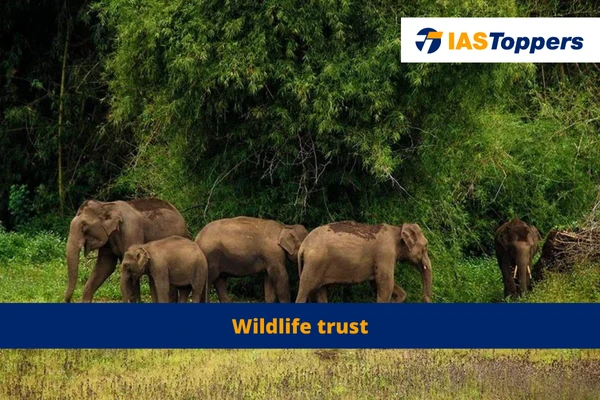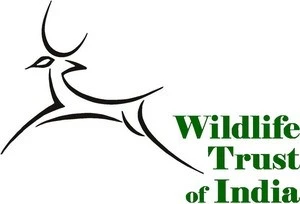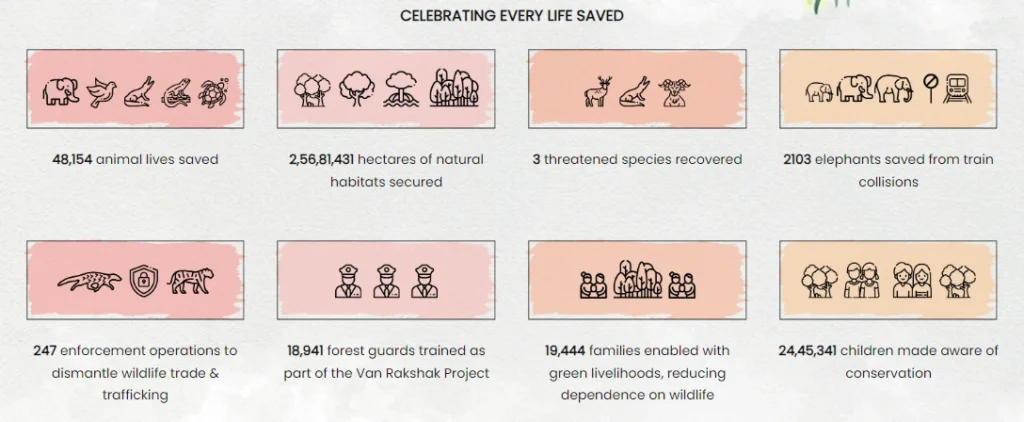Wildlife trust of India is a registered charity in India dedicated to conservation of nature and wildlife in India. In this article, you will learn definition, objectives, initiatives, achievements of Wildlife trust of India, etc.
This article will provide key insights for GS Paper-III Environment and Ecology section of UPSC IAS Exam.
Table of Content
- What is Wildlife Trust of India?
- Objectives of Wildlife Trust of India
- Key activities of Wildlife Trust of India
- Initiatives of Wildlife Trust of India
- Achievements of Wildlife Trust of India
- Projects of Wildlife Trust of India
- Conclusion
- Frequently Asked Questions
- Reference
What is Wildlife Trust of India?
- The Wildlife Trust of India (WTI) is a non-governmental organization dedicated to conservation of nature and wildlife in India.
- The Wildlife Trust of India was established in November 1998 in New Delhi, India.
- The Wildlife Trust of India was formed in response to the decline of wildlife in the country.
- WTI is a registered charity operating under Section 12A of the Income Tax Act, 1961.
Objectives of Wildlife Trust of India:
- WTI aims to deliver 750 short–term, targeted, and innovative aid interventions.
- WTI’s goal is to enhance the well-being of individually displaced animals, while also aiming wildlife health and science-based rehabilitation throughout India.
- Through these efforts they aspire to save at least 40,000 lives over the next decade.
- WTI’s goal is to ensure the recovery of at least six endangered species by improving their recovery categories and enhanced recovery scores.
- WTI’s goal is to enhance the functionality of six selected Protected Areas (PAs) by promoting their effectiveness and utility
- WTI will implement six innovative models to reduce human–wildlife conflict.
- WTI’s strategy includes stopping poaching and trade activities in at least six specific geographical areas.
- WTI can contribute to the protection and preservation of biodiversity including critical habitats in 200,000 hectares outside the traditional Protected Area system.
- These habitats include important habitat linkages, wetlands, grasslands, community reserves, important bird areas, and sacred groves.
- Through the implementation of six planned campaigns, WTI strives to bring a positive change in people’s perceptions to ultimately improve wildlife conservation and welfare in India.
- WTI works towards securing the right of passage for two umbrella species across 50% of their respective landscapes.
- By establishing these corridors, WTI can facilitate the movement and survival of these key species.
Key activities of Wildlife Trust of India:
- WTI focuses its efforts and activities on six key landscapes: northeast India, western Himalayas, terai, southern Ghats system, central India, and terrestrial ecosystems.
- WTI has 44 conservation projects across 23 states.
Initiatives of Wildlife Trust of India
- One of their initiatives includes protection and conservation of the Sarus crane.
- The Wildlife Trust of India has collaborated with the Assam Forest Department to manage the Centre for Wildlife Rehabilitation and Conservation.
- Centre for Wildlife Rehabilitation and Conservation is a facility dedicated for the wildlife care.
- The financial support is also provided by the International Fund for Animal Welfare.
- The Wildlife Trust of India has collaborated with the Chhattisgarh Forest department to look after the Udanti Tiger Reserve located in Gariab and district, Chhattisgarh.
Achievements of Wildlife Trust of India
- WTI has mapped and secured all 101 corridors utilized by Asian elephants in India.
- WTI’s green-print plan and four securement models ensure their protection and preservation.
- By focusing on three flagship species, WTI has safeguarded the canopies, corridors, and catchments of the Garo Green Spine.
- This achievement was accomplished in 16 Village Reserve Forests in the Garo Hills of Meghalaya.
- WTI have successfully provided Level 1 anti-poaching training to more than 16,000 wildlife staff across over 150 Protected Areas.
- WTI has also ensured that more than 20,000 frontline staff members receive ex-gratia assurance or compensation for any death or injury sustained while on duty.
- WTI has influenced the designation of the whale shark as the first fish to be safeguarded under the Wild Life (Protection) Act of 1972 in India.
- Efforts of WTI have rejuvenated the Valmiki Tiger Reserve in Bihar which led to increase in the numbers of tigers and their prey within the park.
- The Manas National Park which was previously listed as a World Heritage Site in danger by UNESCO, has been restored by WTI.
- WTI’s species recovery project has preserved the endangered Central India wild buffalo specifically within the Udanti Wildlife Sanctuary in Chhattisgarh.
- Central India’s wild buffalo serves as the progenitor of the world’s buffalo population.
- A project undertaken to prevent elephant deaths in Uttarakhand has yielded remarkable results specifically in Rajaji National Park where not even a single elephant death occurred due to train.
- Efforts of WTI has formally ban shahtoosh in Jammu & Kashmir and help to replace them by introducing an alternative product called Pashm-e-Shahi, which is more sustainable.
- Efforts of WTI has brought to light the illegal mongoose hair brush trade by advocating its protection under the Wild Life (Protection) Act.
- WTI has collaborated with the Nyishi tribe near Pakke Tiger Reserve, to encourage the use of fibre glass hornbill beaks as alternatives to the killing of four hornbill species for decorative purposes in Arunachal Pradesh.
- WTI has done the first comprehensive survey of the markhor (Capra falconeri), and advocated the declaration of Kazinag National Park.
- Markhor is the largest goat species globally.
- WTI has contributed to the expansion of Hirpora Wildlife Sanctuary and the notification of Tatakuti Wildlife Sanctuary in Jammu & Kashmir.
- WTI has supported the Indian government’s efforts to prevent the reopening of the ivory trade at CITES.
- WTI has supported India’s first anti-snare walks in Bandipur Tiger Reserve in Karnataka.
- WTI has undertook India’s first private-public restoration of a degraded coral reef in Mithapur of Gujarat.
- Animals conserved by WTI:
- Dancing bears
- Kalandars
- Amur falcons of north-east region
- Swamp deer in Assam
- WTI collaborated with the Uttarakhand Forest Department by relocation of Khand Gaon II, and freeing the Chilla Motichur corridor from human habitation to create a secure passage for elephants and other wildlife within the Rajaji Tiger Reserve.
- WTI has successfully secured the Thirunelli-Kudrekote corridor in Wayanad, Kerala.
Projects of Wildlife Trust of India
Gandak Gharial Recovery Project:
- The objective of the Gandak Gharial Recovery Project is to revive the population and expand the presence of the critically endangered Gharial in its natural habitat.
- The Indian Gharial is endemic to the Indian subcontinent which was once found throughout the region, but now it is confined to few areas in India, Nepal, and Bangladesh.
- The gharials are distributed among 14 sub-populations in India and Nepal, with breeding occurring in only six of those sub-populations.
- The majority of the global population or approx. 77%, is found in the National Chambal Sanctuary, situated along the river Chambal.
Kashmir Markhor Recovery Project:
- The aim of the Kashmir Markhor Recovery Project is to enhance the population status of the Pirpanjal Markhor (Capra falconeri).
- In 2004, WTI in collaboration with the Department of Wildlife Protection in J&K and the Environment and Ecology cell of the Indian Army, conducted surveys that established a scientific baseline.
- WTI has explored new habitats suitable for markhor and ensuring the protection of critical areas while assessing the impact of human activities and livestock grazing on markhor and its habitat.
- Pirpanjal Markhor is a species once believed to be extinct, in Jammu and Kashmir.
- The Markhor is the largest wild goat in the world and is endemic to Jammu and Kashmir.
- Markhor is protected in the Wildlife (Protection) Act of 1972 under Schedule-I, and Near Threatened under the IUCN.
Greater Manas Conservation Project:
- The aim of the Greater Manas Conservation Project is to restore the Manas landscape through Wild Rescue, Wild Aid, Enforcement and Law, Species Recovery, and Conflict Mitigation.
- The Manas Landscape is situated at the convergence of 3 distinct bio-geographic realms: the lower Gangetic plain, the Central Himalayas, and the Brahmaputra valley.
- The Manas encompasses five forest types- the Sub-Himalayan High Alluvial Semi-evergreen Forest, Eastern Bhabhar type Forest, Moist Mixed Deciduous Forest, Assam Valley Semi-evergreen Forest, and the Eastern Wet Alluvial Grassland.
- The Manas landscape was earlier designated as being a UNESCO World Heritage Site in 1985.
- The Manas landscape is given multiple recognitions such as a Tiger Reserve, National Park, Elephant Reserve, and Biosphere Reserve.
- The region has suffered due to demand for a separate “Bodoland” by the Bodo community since the late 1980s.
- However, after the formation of the “Bodoland Territorial Council” in 2003 through a tripartite agreement between the Bodoland People’s Front, Government of Assam, and Government of India, peace and normalcy were restored.
- In 2007, WTI influenced the political declaration of the concept of “Greater Manas” for the conservation of the entire landscape by the territorial council.
- Due to these efforts, Manas regained its status as a “World Heritage Site” in 2011.
Whale Shark Conservation Project:
- The whale sharks was hunted along the shores of Gujarat, India.
- The whale shark (Rhincodon typus) was enlisted under Schedule I of India’s Wild Life (Protection) Act, 1972 in 2001.
- The whale shark was categorised in Appendix II of the Convention in International Trade in Endangered Species of Fauna and Flora (CITES).
- WTI launched Whale Shark Campaign to raise awareness among coastal communities in Gujarat.
- The Whale Shark Conservation Project was a collaboration of Gujarat Forest Department, Tata Chemicals Limited (TCL), and Wildlife Trust of India to generate data for the protection of whale sharks in India.
- The project includes various scientific studies such as photo-identification, genetic analysis, and satellite tagging of whale sharks.
Other such projects include:
- Sarus Crane Conservation Project
- Terai Tiger Project
- Kannur Kandal Project
- Protecting Tigers, People and their Vital Habitats in Sunderban Delta of India and Bangladesh
Conclusion
The Wildlife Trust of India (WTI) strongly focuses on biodiversity conservation and address critical issues such as habitat loss, illegal wildlife trade, human-wildlife conflict, and environmental degradation. WTI’s multidisciplinary approach combines scientific research, advocacy, community engagement, and capacity building to achieve tangible results in wildlife conservation. WTI’s conservation projects not only protect wildlife but also helps in the overall ecological balance.
Ref: Source-1
| Other Articles in Environment & Disaster Management | |
| Wildlife Protection Act 1972 | Bonn Convention (Convention on Migratory Species (CMS)) |
| In-situ conservation | National Green Tribunal |
| Ex situ conservation | Eco Sensitive Zone (ESZ) in India |
FAQs (Frequently Asked Questions)
What is Wildlife Trust of India?
The Wildlife Trust of India (WTI) is a non-governmental organization dedicated to conservation of nature in India.
When was Wildlife Trust of India established?
The Wildlife Trust of India was established in November 1998 in New Delhi, India.
What was the goal of Wildlife Trust of India?
The Wildlife Trust of India’s goal is to enhance the well-being of individually displaced animals, while also aiming wildlife health and science-based rehabilitation throughout India.




